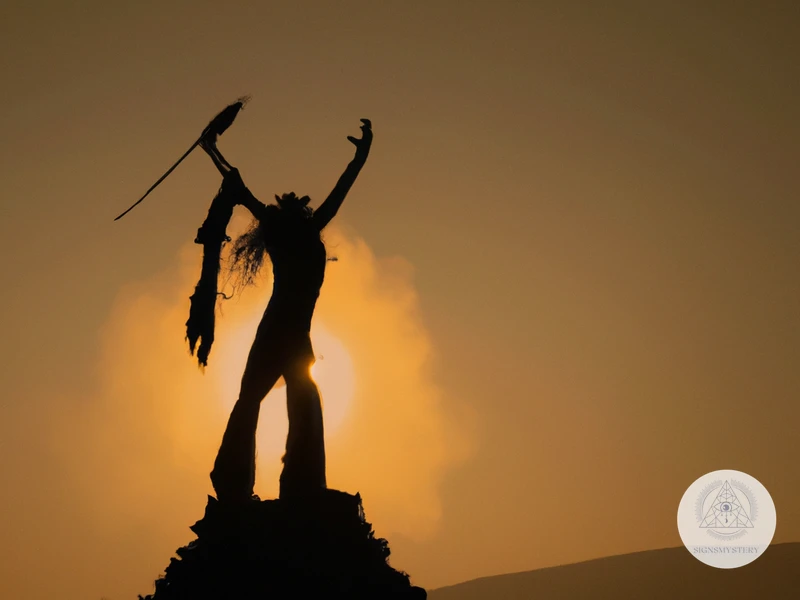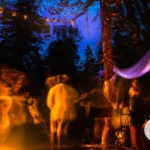Have you ever wondered about the origins of Shamanism? This ancient practice has been around for thousands of years and continues to be an important part of many cultures around the world. But where did it all begin? In this article, we will delve into the prehistoric roots of Shamanism and explore its evolution throughout history. From the evidence of Shamanic practices in prehistoric times to its influence on modern culture, we will examine the role of Shamanism in the past and present. Join us on this journey as we trace the origins of this fascinating tradition and gain a deeper understanding of its significance.
What is Shamanism?

Shamanism is an ancient spiritual practice that dates back to the prehistoric era. It is found in various Indigenous cultures across the world and has evolved over time due to globalization. Shamanism is a way of healing the mind, body, and soul through various traditional practices. It involves connecting and communicating with the spiritual world, nature, and ancestors. The role of the shaman is to act as an intermediary between the spiritual realm and the physical world. Shamanic practices may include the use of herbal medicine, music, dance, and rituals. The practice of shamanism has a rich history and has influenced various cultures and religions. Although it is an ancient practice, shamanism is still practical in modern society.
The Ancient Shamanic practices
Ancient shamanic practices date back to the Paleolithic era, which began around 2.6 million years ago and lasted until around 10,000 BCE. These practices were integral parts of prehistoric cultures and were based on the beliefs that all natural objects, including animals, plants, and rocks, have spirits and that shamanic practitioners can communicate with these spirits.
One of the most common ancient shamanic practices was spirit journeying, which involves entering an altered state of consciousness through meditation, drumming, or ingesting hallucinogens to communicate with spirits and receive guidance. Another important practice was the use of sacred objects, such as crystals, plants, and amulets, which were believed to have healing properties and could protect individuals from harm.
One of the oldest examples of shamanic practices can be found in cave paintings and rock art, which depict trance-like states, animal transformations, and the use of sacred objects. These paintings provide evidence that shamanism was an integral part of prehistoric religions and suggests that it played a significant role in shaping early human societies.
Shamanism in the ancient world wasn’t limited to one geographic area or cultural group. There is evidence of shamanic practices in many regions, including Europe, Asia, Africa, and the Americas. These practices evolved over time as different cultures developed their own unique approaches to shamanism.
It’s also important to note that ancient shamanic practices continue to influence modern shamanic traditions, which have evolved over time to reflect the changing needs and beliefs of their practitioners. Today, many people still practice shamanism as a way to connect with the spirits of nature and receive guidance and healing.
The ancient shamanic practices were an integral part of prehistoric cultures and continue to be an important part of modern spirituality for many individuals around the globe.
The Modern Definition
The modern definition of shamanism centers around the idea of a shaman as a healer and spiritual guide. The term “shaman” is derived from the word “samana” in the language of the Tungus people of Siberia, which means “one who knows.” Today, a shaman is generally understood to be an individual who is able to enter non-ordinary states of consciousness in order to communicate with spiritual entities and access information that is not available in ordinary waking consciousness.
In contemporary shamanic practice, a shaman may use various methods to induce altered states of consciousness, including drumming, chanting, and the use of mind-altering substances. Once in an altered state, the shaman may communicate with spirits, power animals, ancestors, or other entities in order to gain insight, guidance, or healing. This may involve performing rituals, conducting ceremonies, or engaging in various forms of energy work.
One of the key features of modern shamanic practice is an emphasis on personal empowerment and spiritual self-discovery. Practitioners often seek to develop a strong connection with their own spiritual intuition and inner guidance, and to use this connection to help others on their own spiritual journeys. Some modern forms of shamanism also incorporate elements of psychology, meditation, and holistic healing, reflecting an evolving understanding of health and wellness.
While the modern definition of shamanism has evolved considerably from its prehistoric roots, the core principles of spiritual healing, communication with the spirit world, and personal empowerment remain central to this timeless tradition. To learn more about shamanism in different cultures, check out our articles on shamanic practices in Ancient Egypt and shamanism in indigenous cultures. And to explore the origins of shamanic healing, read our article on the origins of shamanic healing.
The Prehistoric World of Shamanism
The Prehistoric World of Shamanism is a fascinating subject that has captured the attention of scholars and enthusiasts alike. There is evidence of shamanic practices dating back tens of thousands of years, found in various regions of the world, from Europe to Asia to South America. These practices involve a range of rituals and beliefs, many of which revolve around the use of hallucinogenic plants and trance-like states. The role of the shaman in prehistoric society was multifaceted, acting as healers, leaders, and spiritual guides. Their relationship with nature was also significant, as they were believed to possess a special connection to the natural world. The emergence and evolution of shamanic practices in prehistoric times are still being studied and debated, and their influence on modern culture remains a topic of interest.
The Evidence of Shamanic Practices in Prehistoric Times
Archeological evidence has revealed the existence of shamanic practices in prehistoric times. Cave paintings in France depict human figures in what appears to be shamanic poses, including trance-like states and animal-inspired costumes. Likewise, similar evidence has been found in other parts of the world, such as the rock art of Australia or the petroglyphs of North America, which display similar images.
Researchers have excavated prehistoric burials that contain artifacts that suggest the presence of shamanic practices. For example, the remains of a young boy dating back 28,000 years were found in Italy, adorned with ornaments and a necklace made of animal teeth. Similar findings have been made in the Americas and Asia, suggesting that shamanic traditions were present in these areas as well.
Another indication of shamanism in prehistoric societies is the use of psychoactive substances such as mushrooms, peyote cactus, and tobacco. These substances are frequently used in shamanic rituals to achieve altered states of consciousness, and their use has been documented among various indigenous cultures around the world since ancient times. Archeological findings of pipes, bowls, and other objects used for smoking or consumption of these substances lend further support to the idea that shamanic practices were present in prehistoric times.
While the exact nature of these ancient shamanic practices remains somewhat mysterious, the evidence strongly suggests that they were an integral part of many prehistoric cultures. It is clear that these early societies were deeply intertwined with the natural world, and that shamans played an important role in mediating between the human and spiritual realms. Understanding the evidence of shamanism in prehistoric times is critical to our understanding of the evolution of human spirituality and the historical roots of this ancient tradition.
The Role of Shamanism in Prehistoric Society
The role of shamanism in prehistoric society was significant and multifaceted. Here are some of the key ways in which shamanism played a role:
| Spiritual Guidance | Shamans acted as spiritual guides who helped people connect with the divine and navigate the spiritual realm. They facilitated communication with spirits, divinities, and ancestors, and provided insights and wisdom on matters of the soul. Shamanic rituals and practices were designed to generate altered states of consciousness that opened the way to spiritual revelations and healing. |
| Healing and Medicine | Shamans were also healers and doctors who used their knowledge of natural remedies, herbs, and plants to cure illnesses and wounds. They were able to diagnose ailments through divination and trance, and then apply the appropriate treatment, which sometimes involved the use of psychoactive substances. Shamans also helped people deal with psychological issues, such as anxieties, fears, and traumas. |
| Cultural Transmission | Shamans played a crucial role in passing down cultural and tribal knowledge from one generation to the next. They helped preserve traditions, myths, and beliefs, and conveyed the history and identity of their people. Shamans were keepers of secrets and sacred knowledge, such as the rituals for hunting, gathering, and agriculture, as well as the laws and taboos of their society. |
| Community Leadership | Shamans were often respected leaders who had great influence over their community. They mediated conflicts, settled disputes, and acted as diplomats and negotiators in inter-tribal relations. They were also advisors to chiefs and rulers, and played a role in governance and decision-making. Shamans were held in high regard for their wisdom, integrity, and spiritual power. |
| Ecological Balance | Shamans were intimately connected to nature and the environment, and saw themselves as stewards of the land. They helped maintain the balance between humans, animals, plants, and other elements of the ecosystem, and ensured the prosperity and sustainability of their community. They also performed rituals and ceremonies that acknowledged the spiritual dimension of nature and celebrated the cycles of life and death. |
Shamanism was a vital and integral part of prehistoric societies, providing spiritual, social, cultural, and ecological benefits to their members. Its legacy has endured to this day, shaping the way we think about the world and our place in it.
The Relationship between Shamanism and Nature
Shamanism is a practice that has a deep connection with nature. The relationship between shamanism and nature is fundamental to the shamanic tradition. The shamanic practice entails connecting with nature on a spiritual level to heal, seek wisdom, and restore balance in the world.
Shamanism recognizes the interconnectedness of all things. In the eyes of a shaman, everything is connected – the trees, the animals, the mountains, the water, and even the spirits. Everything in nature is seen as alive and imbued with spirit, and the shaman seeks to connect with these spirits to learn from them, communicate with them, and use their knowledge to heal people and the environment.
Nature is the source of shamanic power. The shamanic practice is ultimately rooted in the natural world. Shamanic power is often drawn from the forces of nature – the wind, the water, the earth, and the fire. The shaman believes that by working with natural elements and forces, he or she can harness their power to heal individuals, communities, and the natural world.
Shamanic practices encourage harmony and balance with nature. Nature is respected and revered in the shamanic practice, and shamanic rituals often involve invoking the balance and harmony of nature. Many indigenous cultures that practice shamanism see themselves as stewards of the natural world, and the shamanic practice often involves working to maintain the balance between humanity and nature.
Shamanism helps us connect with our primal nature. In modern society, we have become disconnected from the natural world and our primal selves. Shamanic practices help us tap into our primal nature and reconnect with the natural rhythms of the world. By going deep into nature, shamanic practitioners seek to reconnect with our roots and our essential humanity.
The relationship between shamanism and nature is deeply intertwined. Shamanic practices seek to establish a connection with nature in a way that respects and honors the natural world. By understanding the interconnectedness of all things and tapping into the power of nature, shamanic practitioners can help restore balance and harmony to ourselves, our communities, and the world around us.
The Emergence of Shamanism in Different Regions of the World
The emergence of shamanism in different regions of the world is a fascinating topic to explore. Shamanic practices have been found in various archaeological sites, suggesting that shamanism was a worldwide phenomenon. It is believed that shamanic traditions emerged independently in different parts of the world, highlighting the human need for connection with the spiritual realm and the natural world.
Asia: Shamanism has been a part of many Asian cultures for centuries. In Siberia, shamans played an essential role in the community, communicating with spirits and healing the sick. In Central Asia, shamans known as Baksy were respected figures who could heal and provide guidance. In Mongolia, Shamanism is still practised by some, and it played a vital role in Mongolian history.
Africa: African shamanism is vastly diverse, with many unique traditions. In some areas of Africa, shamans or witch doctors were responsible for healing and maintaining social harmony. In contrast, in other regions, their role was more ritualistic. One example is the sangoma in South Africa, who communicates with the spiritual realm and uses divination to provide insight and guidance.
North America: Shamanism played a significant role in the native cultures of North America. The shaman, also known as a medicine man or woman, was believed to have the ability to communicate with spirits to provide healing, guidance, and prophecy. Different tribes had varying traditions, and the shaman was often one of the most respected members of the community.
South America: Shamanism has a long history in South America, with many different traditions. In the Amazon Basin, the ayahuasca ceremony is a well-known shamanic tradition that involves the use of a powerful hallucinogenic brew. In the Andes, the Q’ero people have a tradition of shamanic healing and divination.
Australia: In indigenous Australian cultures, the shaman or “clever man” played an important role in both spiritual and physical healing. They were believed to have the ability to communicate with ancestors and spirits, providing guidance and insight into the natural world.
The emergence of shamanism in different regions of the world highlights the human need for connection to the spiritual realm and the natural world. As we can see, shamanic practices have diverse and unique traditions across the globe. The role of shamanism in these cultures may have evolved over time, but the essence of these practices remains the same.
The Evolution of Shamanic Practices in Prehistoric Times
As prehistoric societies evolved, so did the practice of shamanism. The evolution of shamanic practices can be seen in the artifacts left behind by our ancestors. Early shamans used simple tools to perform their rituals, such as animal bones and feathers. However, as societies became more complex, so did their approach to shamanism. The use of hallucinogenic plants and substances became more widespread, allowing shamans to enter altered states of consciousness and connect with the spirit world.
One notable example of the evolution of shamanic practices can be seen in the Siberian region of Russia. The earliest known shamans in the area practiced a form of shamanism that was focused on hunting, using furs and animal skulls as tools. However, as the region became more settled and agriculture developed, their practices evolved to include healing and divination.
In other parts of the world, shamanic practices evolved to incorporate the use of masks and elaborate costumes. These costumes were often designed to represent the spirits that the shaman would communicate with during their rituals. Additionally, the use of trance-inducing music and dance became more commonplace in shamanic practices, allowing the shaman to enter altered states of consciousness and better communicate with the spirit world.
It is important to note that shamanic practices were not limited to one specific region or culture. Instead, they developed independently in different parts of the world, adapting to the unique needs and beliefs of each society. As such, the evolution of shamanic practices is a testament to the universality of the human experience and our innate connection to the natural and spiritual world.
The Influence of Shamanism on Modern Culture
The influence of shamanism on modern culture is a subject of great interest and debate among scholars and enthusiasts alike. Today, shamanic practices and beliefs can be found in a wide range of fields including art, music, literature, spirituality, and medicine. One of the most significant ways in which shamanism has impacted modern culture is through the growing popularity of spiritual practices based on traditional shamanic beliefs and techniques.
In the realm of art, shamanism has inspired many contemporary artists to incorporate shamanic themes and imagery into their work. For instance, the artwork of Alex Grey, a celebrated American artist, is known for its psychedelic and visionary quality that draws from shamanic traditions. His work reflects the belief in shamanism that the natural and spiritual worlds are interconnected, and that the visions and insights of the shaman are means of accessing higher realms of consciousness.
Similarly, in the field of music, shamanism has influenced many musicians to incorporate shamanic rhythms, chants, and instruments into their compositions. The use of shamanic techniques for healing and spiritual growth has also gained popularity in alternative medicine and therapies. This includes practices such as holotropic breathwork, a technique used for accessing expanded states of consciousness, and ayahuasca, a plant medicine used in traditional Amazonian shamanic practices for healing and spiritual
Subscribe to Our Newsletter
Sign up to receive the latest news and updates.
In modern literature, shamanism has been a popular subject of study and inspiration, with many authors exploring traditional shamanic practices and beliefs. Works of authors such as Carlos Castaneda, Michael Harner, and Ted Andrews have been instrumental in introducing shamanic practices and beliefs to a wider audience.
Shamanic practices continue to play a significant role in contemporary spirituality and religion. A growing number of people are seeking spiritual experiences that go beyond traditional religious structures and dogmas, and shamanic practices have emerged as a way for individuals to explore their inner selves and connect with the higher realms of consciousness in a more personal and direct manner.
The influence of shamanism on modern culture is undeniable. It has inspired and influenced artists, musicians, writers, and spiritual seekers alike, and has played a significant role in shaping our understanding of human consciousness and the interconnectedness of all things. As modern society continues to evolve, it is likely that shamanic practices and beliefs will continue to gain in popularity and influence in many spheres of life.
The Evolution of Shamanic Traditions in History
Shamanic traditions have undergone significant changes throughout history. In the early civilizations, shamanic practices were an integral part of the culture and religion. However, the growth of organized religion had a significant impact on shamanism, leading to its decline in some regions. Despite this, shamanic traditions continued to thrive in various cultures, with practitioners adapting their practices to fit their beliefs and environment. The role of shamanism in modern society has also evolved, with more people turning to it as a form of alternative healing and spirituality. The evolution of shamanic traditions is a testament to the resilience and adaptability of this ancient practice, and its continued relevance in the modern world.
Early Civilization and Shamanic Practices
Early civilizations across the world practiced various forms of shamanism as a way to communicate with the unknown, seek divine guidance, and connect with spirits. The practice of shamanism in early civilizations was often intertwined with religious practices, and shamans held a significant position in society as healers, leaders, and spiritual guides.
In ancient Mesopotamia, the Sumerians practiced shamanism alongside their religious rituals. They believed that spirits controlled every aspect of their lives and sought the help of shamans to communicate with these spirits. Shamans in Sumerian society were highly respected and were often responsible for predicting the future and healing the sick.
Similarly, Ancient Egypt had a strong tradition of shamanism. Egyptian shamans, or “hem-netjer,” were thought to possess the power to communicate with the gods and act as intermediaries between the gods and the people. They were often called upon to perform healing ceremonies, exorcisms, and divination.
Shamanism played a central role in the religious practices of the Native American tribes of North America. Each tribe had their own unique shamanic traditions and beliefs, but all practiced some form of communication with spirits using various techniques like drumming, chanting, and dancing. In many tribes, shamans acted as healers and were believed to have the power to cure illnesses by communicating with spirits.
The ancient Greeks also practiced shamanism in the form of mystery cults. These cults were shrouded in secrecy and involved initiation ceremonies and rituals to connect with the gods. The Eleusinian Mysteries, for example, were a series of secret rituals dedicated to the goddess Demeter that were believed to ensure a good afterlife.
The ancient Celts of Europe also had their own shamanic traditions, known as druidism. Druids were the spiritual leaders of Celtic society and were thought to have the power to communicate with the spirits of nature. They were also responsible for performing divinations, healing ceremonies, and sacrifices.
Shamanism played an important role in the early civilizations of the world as a way for people to connect with the divine and unseen forces of the universe. It was a powerful tool for healing and for seeking guidance and served as a bridge between the physical and spiritual realms.
The Impact of Religion on Shamanism
The impact of religion on shamanism has been a complex and often controversial subject. Throughout history, many religions have emerged that have influenced shamanic practices around the world, often resulting in the assimilation of shamanic practices into these new religious systems.
One of the most significant impacts that religion has had on shamanism has been the process of syncretism. As different religions have encountered shamanic traditions in various cultures, there has often been a blending of beliefs and practices, resulting in the creation of new, hybrid forms of spirituality.
Central to this process of synthesis has been the desire of organized religions to dominate and control the practices of shamans and other spiritual practitioners. In many cases, religious authorities have sought to incorporate shamanic practices into their own systems, while simultaneously denigrating or suppressing the indigenous shamanic traditions.
This process has played out across the world, from the syncretism of shamanic practices within Tibetan Buddhism, to the incorporation of traditional shamanic ceremonies into the Catholic Church in South America.
At the same time, however, religious influence has not always been negative for shamanic traditions. In some cases, religions have provided a protective umbrella for shamanic practices that might have otherwise been destroyed by colonialism or by the creeping influence of mainstream modern culture.
Some religious systems have provided a fertile ground for the evolution of new forms of shamanism. In particular, the New Age movement has been an important driver of the growth of modern shamanic practice, both in terms of its spiritual pluralism and its emphasis on personal spiritual experience.
The impact of religion on shamanism has been a complex and often fraught one, with both positive and negative effects. However, in the long term, the resilience and adaptability of shamanic practice means that it is likely to continue to evolve and grow, even in the face of these challenges.
The Growth of Shamanism in Different Cultures
Shamanism is a spiritual practice that has been present across different cultures throughout history. As societies evolved and civilizations developed, shamanism also underwent changes and adaptation to different cultural contexts.
The Americas: In the Americas, shamanism was present in indigenous cultures long before the arrival of Europeans. Among Native American tribes, shamanism was a central aspect of spiritual and cultural life. Shamans served as mediators between the human and spirit worlds, and were responsible for healing, divination, and protecting the community from harmful spirits.
Central Asia: In Central Asia, shamanism has been practiced for millennia among various nomadic peoples such as the Mongols, Tuvans, and Yakuts. Shamans in these cultures were regarded as powerful figures who could communicate with spirits and perform rituals to ensure the prosperity and well-being of the community. Shamanism was also closely associated with the natural world and the cycles of the seasons.
Siberia: Among the indigenous peoples of Siberia, shamanism has been an important spiritual practice for thousands of years. The shaman, also known as the “hesteg,” had the ability to communicate with spirits and the ancestors, and was responsible for healing people and preventing misfortune. Shamanic rituals in Siberia often involve the use of drums, incantations, and trance-like states.
Africa: In Africa, shamanism took on many different forms depending on the cultural context. Among the San people of southern Africa, shamans were known as “xara” and were responsible for healing people and communicating with the spirit world. In West Africa, shamanism was often associated with voodoo and other forms of animistic belief systems.
Australia: Aboriginal cultures in Australia have also practiced shamanism for thousands of years. Shamans in these cultures were known as “ngangkari” and were responsible for healing people and communicating with the spirit world. The role of shaman was often passed down through family lines.
Shamanism has taken on many different forms in different cultures throughout history, but it remains a powerful spiritual practice that continues to have relevance in modern times. As societies continue to evolve, shamanism will no doubt continue to adapt and grow, drawing on the wisdom of the past to shape the spiritual practices of the future.
The Role of Shamanism in Modern Society
The role of shamanism in modern society is complex and multifaceted. While the traditional practices of shamanism are still preserved and practiced by indigenous cultures around the world, shamanic beliefs and practices have also been adopted by people in urban settings seeking alternative spiritual paths.
One of the most notable roles that shamanism plays in modern society is as a source of healing. Many people turn to shamanic healers for physical, emotional, and spiritual healing, often when conventional Western medicine fails to provide a cure. Shamanic healing techniques such as soul retrieval, energy healing, and plant medicine ceremonies are gaining popularity in the Western world as more people seek alternatives to mainstream medical treatments.
In addition to healing, shamanism also serves as a source of guidance and spiritual development for many people. Through practicing shamanic meditation and ceremony, individuals can explore their inner selves and connect with the natural world around them. This can lead to a greater sense of purpose and fulfillment in life, as well as a deeper appreciation for the interconnectedness of all things.
Shamanism also has a role to play in environmentalism and promoting sustainable living. Traditional shamanic cultures have long recognized the importance of living in harmony with nature, and this philosophy is becoming increasingly relevant in our modern world. As more people become aware of the impact of human activity on the planet, shamanic teachings can offer valuable insights into how we can live more sustainable, earth-friendly lives.
The role of shamanism in modern society is diverse and evolving. While some may view it as a relic of the past, others recognize its relevance in addressing the complex challenges of our time. As shamanism continues to evolve and adapt to different cultural contexts, it will likely continue to play an important role in guiding individuals and communities towards greater spiritual and environmental awareness.
Conclusion
After exploring the prehistoric roots and evolution of shamanism, we can conclude that shamanism has been an integral part of human history and culture. Its practices and beliefs have shifted and evolved over time, but the core principles of connecting with nature and the spirit world remain a constant.
We have seen how shamanism has played a crucial role in prehistoric societies, serving as healers, spiritual guides, and community leaders. Shamanism’s influence can also be seen in the religious practices of many later civilizations, such as ancient Egypt, Greece, and Rome.
Today, shamanism continues to thrive and evolve in various cultures around the world. The modern definition of shamanism is more inclusive, recognizing the diversity of shamanic practices and traditions. The role of the shaman has also expanded, ranging from spiritual healers to environmental advocates.
As we look back on the history of shamanism, it is evident that it has had a profound impact on the human experience. Through shamanic practices, humans have found ways to connect with the natural world, the spirit world, and each other. By exploring our prehistoric roots, we gain a deeper understanding of the evolution and significance of shamanism throughout history.
To sum up, shamanism still has much to offer to modern society, with its emphasis on spiritual connection, healing, and environmental stewardship. We should continue to explore and learn from the diverse shamanic traditions that have emerged from prehistoric times, and find ways to incorporate these practices into our lives in a respectful and meaningful way.
Frequently Asked Questions
What is the definition of shamanism?
Shamanism is a practice that involves the interaction of a practitioner, called a shaman, with the spiritual world. It is a belief system that has been present in cultures throughout history and is still practiced in various forms today.
What are the ancient shamanic practices?
Ancient shamanic practices include rituals, ceremonies, and the use of natural substances to achieve altered states of consciousness. These practices were used for healing, guidance, divination, and communication with the spiritual world.
What is the modern definition of shamanism?
The modern definition of shamanism encompasses a wide range of practices that involve the use of spiritual tools and techniques. It is often associated with New Age movements and alternative healing practices.
What is the evidence of shamanic practices in prehistoric times?
The evidence of shamanic practices in prehistoric times includes cave paintings, artifacts, and remains of tools used in shamanic rituals. These practices were present in cultures all around the world.
What was the role of shamanism in prehistoric society?
The role of shamanism in prehistoric society was multifaceted. Shamans were healers, spiritual leaders, and mediators between the living and the spiritual world. They played a crucial role in ensuring the well-being of their communities.
How was shamanism related to nature in prehistoric times?
Shamanism was closely related to nature in prehistoric times. Shamans believed that everything in the natural world was connected and had spiritual significance. They used nature as a source of healing and guidance.
How did shamanism emerge in different regions of the world?
Shamanism emerged in different regions of the world independently. It was present in societies in North and South America, Africa, Asia, Europe, and Australia. Although the practices differ, the belief system is similar across all cultures.
How did shamanic practices evolve in prehistoric times?
Shamanic practices evolved in prehistoric times as societies became more complex and developed. Practices were adapted to meet the needs of the community and new tools were developed to aid in shamanic rituals.
What was the impact of religion on shamanism?
Religion had a significant impact on shamanism in many cultures. In some cases, shamanism was integrated into the religious practices of the culture. In others, it was suppressed in favor of the dominant religion.
What is the role of shamanism in modern society?
The role of shamanism in modern society varies widely. It is still practiced in some cultures as a way of maintaining spiritual traditions. It has also been adopted by New Age movements as an alternative healing practice.










